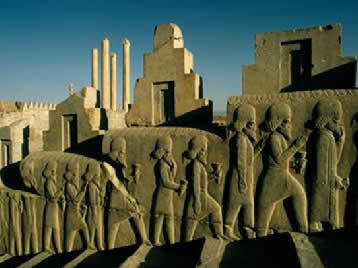Persian art received a great contribution from Mesopotamian and Egyptian styles. Persian architecture had, however, a very original character in the harmonious combination of foreign elements, in the luxury of the decoration and the grandeur of the structures, but we cannot consider Persian architecture as an art popular. Persian architecture was, above all, a creation of kings for their own exaltation. An example of such glorification is the city of Persepolis, today Iran, built in 520 BC. a., that was one of the great capitals of the Persian Empire.

Persepolis – imposing architecture, crafted in silver and gold. Relief sculptures symbolize offerings to the king.
The existence of cities like Pasárgada and Susa clearly demonstrated – through their immense palaces and their magnificent halls supported by columns in an extremely original style, and capitals with motifs based on the heads of a horse, eagle or bull – the art of the great sovereigns Persians. The large buildings had enameled tile covering in bright tones that generated a great ornamental effect. the bronze
inlaid it was used on the doors. O gold and silver they were also carefully crafted.
Pasargada - Tomb of Cyrus - The first Emperor of Persia

Palace of King Darius I the Great
Persian sculpture was strongly Assyrian. The most famous relief is that of Behistum, a gigantic rock measuring 456 meters high, covered with inscriptions and carvings that narrate episodes from Persian history.

The Behistum Monument
Given the religious conceptions of the Zoroastrianism (monotheistic religion founded by the prophet Zarathustra) there was no religious architecture in Persia, however, in several parts of present-day Iran, stone tables are still found called fire places which were ancient altars of the cult Zoroastrian. Later, Persian art suffered a strong Greek influence, especially after the conquest of Alexander the Great, when the rigid schematism of representations of the human body was replaced by Hellenic plastic freedom.
Lilian Aguiar
Graduated in History
